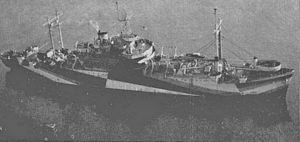USS Mount Olympus (AGC-8)
 USS Mount Olympus (AGC-8) | |
| History | |
|---|---|
| Laid down: | 3 August 1943 |
| Launched: | 3 October 1943 |
| Commissioned: | 24 May 1944 |
| Decommissioned: | 4 April 1956 |
| Struck: | 1 June 1961 |
| Fate: | |
| General Characteristics | |
| Displacement: | 12,142 tons |
| Length: | 459 ft 2 in (140 m) |
| Beam: | 63 ft (19.2 m) |
| Draft: | 25 ft |
| Speed: | 15 knots |
| Complement: | 729 |
| Armament: | 2 × 5"/38 caliber dual purpose gun mount 8 × 40 mm guns (4 × 2) 20 × 20 mm guns (20 × 1) |
USS Mount Olympus (AGC-8) was a Mount McKinley class amphibious force command ship named after the highest peak in the Olympic Range of Washington (U.S. state). She was designed as an amphibious force flagship, a floating command post with advanced communications equipment and extensive combat information spaces to be used by the amphibious forces commander and landing force commander during large-scale operations. Mount Olympus was a commissioned ship for 12 years and 7 months. She received two battle stars for World War II service.
1943-1944
Mount Olympus was laid down on 3 August 1943 at the North Carolina Shipbuilding Company in Wilmington, North Carolina; launched on 3 October 1943 as Eclipse, a transport, sponsored by Mrs. W. C. Park; renamed Mount Olympus on 27 December 1943; and commissioned at Boston, Massachusetts, after conversion on 24 May 1944, with Captain J. H. Schultz in command.
Mount Olympus departed the east coast in early July, arriving Hawaii via the Panama Canal 23 July. With Commander, 3d Amphibious Force, embarked, she was underway from Hawaii 29 August. She arrived Leyte Gulf 20 October, serving as the afloat headquarters for the invasion force. The landing force was subjected to constant air attacks but its survival was assured by the American naval victory in the Battle of Leyte Gulf, which destroyed the Japanese Navy as an effective combat force.
On 26 October, the flagship departed for Hollandia, New Guinea, via Peleliu, in preparation for the next assault on the Japanese occupied Philippines. After invasion rehearsals in Huon Gulf, New Guinea, the ship departed Manus Island, Admiralties, 31 December for the assault on Lingayen Gulf.
1945
That assault took place on 9 January 1945. After the initial assault and with the ground force commander disembarked, Mount Olympus was underway 11 January from Lingayen Gulf. She called at Ulithi to allow Commander, 3d Amphibious Force, to disembark to travel by plane to Hawaii, while she herself sailed for overhaul at San Francisco, California, arriving 11 February and leaving 22 April for Hawaii and Guam.
Arriving Guam 6 July, Mount Olympus sailed on for Manila, colliding en route with oiler USS Millicoma (AO-73). The flagship was escorted to San Pedro Bay, Leyte, for repairs by USS Ajax (AR-6), then continued to Manila, arriving 3 August. After the close of hostilities, Mount Olympus arrived Tokyo Bay 2 September with the 1st Cavalry Division on board for Yokohama.
1946-1949
After 8 months’ moving occupation troops from the Philippines and other bases to ports in Japan and China, she left Shanghai 28 May 1946 for San Diego, the Panama Canal, and New York, arriving 7 July.
In September she was made flagship for operation “Highjump,” the Navy Antarctic Expedition. The ship sailed from Norfolk 2 December, passed through the Panama Canal to rendezvous with the Pacific group, and with them reached Bay of Whales, New Zealand, 16 January 1947. Detached 11 February, Mount Olympus returned Norfolk 17 April to become flagship of Commander, Amphibious Group 2, in training along the eastern seaboard and in the Caribbean.
1950s onward
She became flagship and temporary headquarters for CINCNELM/CINCSOUTH in the Mediterranean 21 June 1951.
Relieved by USS Adirondack (AGC-15) in August 1951, Mount Olympus returned to Norfork and duty as Amphibious Group 2 flagship, joining in NATO naval exercises “Mainbrace” and “Longs” in northern Europe and the Mediterranean from August to December 1952.
After an overhaul in Norfolk from December to March 1953, when a helicopter deck was installed, she served in the Atlantic Fleet until 5 January 1955, when she sailed for the Panama Canal and San Diego, arriving 23 January.
Having participated in exercise “Surfboard” off the coast of Washington (U.S. state) in February, Mount Olympus proceeded to Arctic waters as part of Project 572 in support of DEW Line operations, While underway from Point Barrow to Point Hope, Alaska, she became icebound, but was freed by the icebreaker USS Burton Island. Having sustained damage to structural bulkheads from the ice pressure, the ship was repaired by Current in Point Hope. Mount Olympus returned to San Diego on 29 September and on 31 October 1955 proceeded to Mare Island Naval Shipyard for inactivation. She decommissioned on 4 April 1956 and was struck from the Navy list on 1 June 1961. The ship transferred to the Maritime Administration in June 1966 and remained in the Maritime Administration Reserve Fleet, Suisun Bay, California, into 1969, when this record ends.
References
- Dictionary of American Naval Fighting Ships (Primary source for this article)